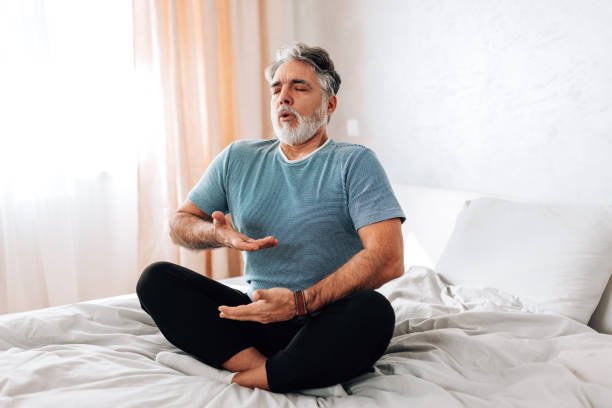Introduction
Mindful living and care is an essential practice that obtains tremendous importance in the modern world. Unless people learn to be self-observant of their activities, very little in substance can be achieved in today’s distracting environment.
The central concept within mindful living and care is the management of being present at the moment, allowing oneself to be completely open to whatever life presents. This offers the opportunity for more profound and genuine living. The practice not only gives mental clarity and emotional strength but also provides peace and contentment.
By applying mindful living and care to one’s everyday life, so will a person find their general well-being improving day by day, with less stress and anxiety and greater physical health and interpersonal relationships. Top 10 Ultimate Strategies for Mindful Living and Care: In this paper, discuss tips and techniques which can be easily integrated into daily life
Strategy 1: Practice Daily Meditation
Mindful Living and Care

More so, Mindful Living and Care start with the basic tenet of meditation on a daily basis, which forms the cornerstone of mindfulness. Mentally and physically, several benefits come by way of this specific form of discipline in meditation. Meditation is the discipline or practice that consists of holding the mind peacefully and consciously clear while it is free from thinking; the result is a very significant calm and lucidity within life. Regular meditation brings reduced tension, improved concentration, and a healthy emotional life by allowing for better knowledge of thoughts and feelings.
It has also been discovered that meditating will help one sleep, bring down high blood pressure, and increase the immune system—all very important tools for overall good health. First of all, start with a quiet and comfortable place that will not be disturbed. Begin with a few minutes a day and slowly increase the timing when you become more comfortable with the process.
Either lie down or sit comfortably and close your eyes. Then, focus on breathing. Just let your thoughts pass by, not crossing your mind. For beginners, guided meditation or meditation apps may be quite helpful in that they structure and support the establishment of a person’s practice. In meditation, it is important to be regular. Therefore, maybe it will be good to establish such a routine when one mediates probably at the same time every day.
You can also construct an area that contributes toward increasing your meditation capabilities. Find a place that looks very serene and neat, then add elements that may make it inviting—candles, cushions, or calming smells. Integrating things that remind you of nature will further drive home the meditative feeling within you—plants or even some natural light. Integrating daily meditation into your life can prove to be a life-changing decision for mindful living and care, where one strives to find ways of sailing through the complexities involved in modern life with calmness and poise.
In just a few moments each day, then, you will be able to give yourself a very peaceful place inside that will let you start each new day with new vigor and serenity for the sake of your general well-being. Begin this journey of meditation every day and learn how that might change your life and well-being.
Strategy 2: Mindful Eating Habits

It extends to being mindful of how we take care of our bodies and live, of which mindful eating is one of the Fundamentals. It means giving full attention to the process of eating and drinking from what one consumes down to how it is taken. This simply means being in the present moments with the sensations of taste, texture, smell, etc. sans other kinds of distractions, such as the TV or the telephone Mindful Living and Care.
This enhances our relationship with food, increases the pleasure derived, and enables much healthier eating practices. It’s proven that mindful eating is associated with better digestion, improved portion control, increased appreciation of food, among other benefits. Mindful Living and Care
It means slowing down and savoring the food for increased tuning to the body’s normal hunger and fullness triggers to avoid overeating and hence maintain weight. Choice of food—whole and nutritious—forms the first step toward starting to practice mindful eating to feed the body and the mind. Mindful Living and Care
Eat at a table rather than on the go or in front of a screen. Take small bites. Chew slowly. Enjoy each bite. Notice the flavors, textures, sensations of eating: Pay attention to your body’s hunger and fullness cues, stopping when you feel satisfied rather than full. Mindful Living and Care
Keep track of your emotional eating triggers: what situations make you want to eat due to stress, boredom, etc., and substitute another behavior for that craving. You can start incorporating some of the mindful eating skills into your life in very small ways. Start with one meal a day where you practice these techniques, and work on the rest of the meals and snacks. Mindful Living and Care
Gradually, mindful eating will become rather natural and intuitive nourishment both for the body and mind, conducive to health and mindful living/care. Mindful Living and Care
Strategy 3: Incorporate Yoga into Your Routine

As concerns mindful living and care, it is very helpful to include yoga in routine daily activities for the good of the mind and body. Originating from India, yoga is an age-old practice and comes with a number of benefits that attribute to general well-being. It brings together physical postures, and meditation, intending harmonious union between the body, mind, and spirit. Mindful Living and Care
It improves flexibility, strength, and balance of the body, and hence improves postures and prevents injuries. Apart from the primary physical advantages, yoga also helps people to have clear mental vision, develop concentration, reduce stress and anxiety, and relax through its mindful and breathing practices. Mindful Living and Care
The various forms of yoga practices bring different emphasis and benefits. Hatha yoga is one that really puts much emphasis on physical postures and is very suitable for beginners. Vinyasa or Power yoga has more dynamic movements and ensures cardiovascular benefit. Restorative yoga involves mild poses, held for extended periods, to promote deep relaxation and relieve stress.
Knowing your level of fitness and health goals—followed only by personal preference—will help you make the right choice for a type of yoga first of all. Those totally new to yoga should begin with a basic Hatha or beginner-friendly Vinyasa class to develop familiarity and confidence. Mindful Living and Care
A ton of material is available online for those who practice at home: there are yoga apps, websites, and video tutorials. Many studios and gyms also provide introductory classes or workshops that help one to get started. Mindful Living and Care
You don’t have to invest a lot of time to build yoga into your daily life—a few minutes a day will pay dividends. Whether you are seeking physical fitness, mental clarity, or spiritual growth, yoga provides how-to in health improvement and embracing Mindful Living and Care. Mindful Living and Care
Strategy 4: Create a Mindful Morning Routine

Mindfulness from the start sets a good, productive day ahead, therefore becoming a cornerstone of good well-being in Mindful Living and Care. A mindful morning routine enhances mental clarity and emotional resilience but also gives a person intentionality and purpose with daily activities. Individuals find more focus, creativity, and satisfaction in their lives when they take time each morning for activities nourishing to their minds, bodies, and spirits. Mindful Living and Care
Begin the mindful morning with meditation or some deep breathing to center yourself and calm your mind. It helps one to reduce stress, build more self-awareness, and feel peace of mind.
Whether meditation is done or not, journaling has the ability to be quite a strong exercise in processing thoughts and emotions, setting ends, or just showing appreciation. Great use of recording intention for the new ahead may help a person understand priorities and proactive actions.Other examples of mindful morning activities to include are gentle stretching or yoga for waking up the body.
Prepare your breakfast, eat it, and enjoy every morsel so that it feeds your body. Take a short walk outdoors or do any other activity that calms your mind, such as reading or listening to soft music. These activities instill mindfulness within the mind to be taken through to a day filled with more positive productivity, creativity, and wholesomeness. Mindful Living and Care
A mindful morning routine helps one to harness the powers of Living Intentionally every morning and deepen their connection with Self and surroundings. As suggested by Mindful Living and Care, such practices promote balance in living, building resilience toward the challenges of everyday life, and taking a more connected attitude to life moments in general. Mindful Living and Care
Strategy 5: Practice Gratitude Daily
It is gratitude that sustains or oversees the States of Mind and Well-being of positive mentalities for Mindful Living and Care. Gratitude shifts our focus from what we lack to the abundance present in our surroundings, enhancing in us the feelings of positivity and resilience. Studies have proved that gratitude practices improve mood, lessen stress, and increase happiness and life satisfaction.
Start a gratitude practice by taking a few minutes every day to meditate and subsequently jot down things you are thankful for. Keeping a gratitude journal can be as easy and painless as recording whatever comes to mind, whether it is particular moments, people, or experiences that made one happy or straightforward things one is appreciative of in their life.
If done consistently, gratitude is just an everyday act. Pick out a part of the day—up in the morning or before going to bed—to take up. If one would want, tie gratitude to daily routine activities, such as one does during meditation or over a cup of preface coffee in the morning.
It can be a review of as simple things as major and minor blessings, such as the sun’s warmth on one’s face or loved ones present in one’s life. Over time, these gratitude practices can shift one’s focus toward meaning and the positive, even when events are challenging.
Live mindfully and take care every day by being thankful—developing an attitude, thankfulness, and appreciation. This brings you to an ample ability to pass through life’s ebbs and flows with elegance and gratitude. Begin now and see how gratitude can help make a difference for betterment in your life into one of happiness and fulfillment.
Strategy 6: Engage in Mindful Breathing Exercises

Mindful breathing becomes an empirical way of generating peace from within while carrying out Mindful Living and Care. Through this act, a person is capable of creating inner peace and fostering health maintenance with the practice of mindful respiration. Mindful breathing would then mean paying full attention to the process of breathing. It doesn’t only ground us in the present moment; it soothes the body and the mind, cutting down on our stress levels through breathing. On inhalation and exhalation, the Mind gets soothed, and the Body relaxes; this causes clarity and peace to be instilled in one’s being.
Mindful breathing exercises can be as simple as they are profound. Find a comfortable seated or lying position with your eyes closed and breathe slowly, deeply. Feel your lungs fill through your nose, then exhale slowly through the mouth.
Feel every sensation of the breath as it comes in and out of the body, not noticing other distracting thoughts or worries. Another exercise is also powerfully done through proper diaphragmatic breathing with conscious awareness—you can do this by placing one hand on your stomach and feel it going up and down with every inhale and exhale; this will help further relax you and also oxygenate your body.
You can easily fit mindful breathing into your daily activities. Begin the day with a few minutes of mindful breathing to help set a peaceful and focused day.
You can practice mindful breathing during highly stressful or minded times of your day to help center yourself and give you perspective. You can also use mindful breathing while walking, during other exercises, and in any other places you find yourself waiting in line. In doing so—that is, by making it a regular practice—it will help to build up resilience and inner strength with which one will easily sail through life challenges and be more mindful. Try now and feel the great benefits of mindful breathing on your general well-being and peace of mind.
Strategy 7: Limit Digital Distractions

The pervasive presence of digital distractions in Mindful Living and Care is quite a challenge to the human capacity for remaining present and linked with the self and others. This might range from digital devices such as mobile phones through computers, all capturing human attention, decreasing mindfulness, and increasing stress levels. Excessive screen time is related to sleep pattern disruption, low productivity, and high anxiety levels; hence, it is quite important to learn how to manage digital consumption for good mental health.
Put a rein on digital distractions by limiting screen time and having occasional digital detoxes.Start setting limits for when and how often one is on digital devices. Establish tech-free zones within the house—for example, no digital devices either in the bedroom or dining area—so that both time isn’t disrupted by gadgets and one can unwind or go out and bond with family members.
Schedule specific emailing and social media times so that there are blocks for concentrated work or leisure time without intrusive digital activity. Offset Digital Overstimulation Balanced activities, most of which are meant to increase mindfulness and presence—reading a book, walking in nature, or even meditation—are advised as against digital overstimulation.
These are the turn-off notifications, apps that track or set limits for screen time, especially before going to sleep.By being proactive at the limitation of digital distractions, Mindful Living and Care will return the moments for self-reflection, creativity, and deep connections that bring balance and fulfillment to life. Take the challenge of digital consumption with mindfulness and rejoice in the deep benefits more deliberate and mindful ways of using technology will bring.
Strategy 8: Connect with Nature

Being connected to nature creates a deep opportunity to rejuvenate the mind, body, and spirit in the pursuit of mindful living and care. To this end, periods spent outdoors are useful for mental health and general wellbeing. Nature has this free calm atmosphere that invites mindfulness, mitigates stress levels, and enhances a sense of peace and clarity.Whether walking in a park, hiking in mountains, or simply sitting near a lake, all such experiences evoke feelings of awe and gratitude. These are the times to nurture and deepen the bonding between self and surroundings.
Other outdoor mindful activities could be a mindful walk where every step and the feeling while stepping is noticed as one has a walk in nature, or the nature meditation that includes finding a quiet place to sit down and watch—feel/sense—the sights, sounds, and sensations of the natural world. Added to this effect are activities like gardening, bird-watching, and picture-clicking.
Nature time is such a great investment to work into your routine, so take some time off from the job or study and get outside to refresh your mind so you may come back and be more creative. Organize hikes or outings in nature on weekends with friends or family; this way, you will join quality time with the added advantage of earning nature’s healing properties.
Build rituals in nature. Begin your day by walking at dawn, end your day with star gazing, and take a course to learn much more about the rhythms of nature. Tips on maximizing the benefit potential as exercised in nature include being able to unplug from digital devices to let loose and live in the moment; going outdoors to do some deep breathing exercises or mindful contemplation; and embracing every season of life in order to let one undergo the changeable beauty that nature exhibits throughout the year.
Put time spent in nature to the top of your list as part of Mindful Living and Care, nourishing a sense of awe and appreciation for the world around you. Take a chance to heal again with nature’s power and allow the shifts that occur when you bring a little more nature into each everyday moment.
Strategy 9: Cultivate Mindful Relationships
Thus, mindful relationships are the real deal of mindful living and care. It is that which enables meaningful reach-out and helps in polishing emotional well-being. Mindfulness in relationships means not being distracted while interacting with others, embracing empathy, and fostering a sense of genuine connection.. With mindfulness practices in any relationship, it offers a better platform for the two people to communicate and understand each other more clearly, creating a supportive environment where the two people involved feel valued and respected.
The importance of mindfulness in building and sustaining relationships lies in the reduction of misunderstandings, strengthening of emotional bonds, and encouraging mutual trust and respect. Active listening is the major tenet of mindful communication—listening to others without judgment or distraction but seeking to understand them and their feelings. We are talking about being present in interactions; this means fully giving attention to the speakers, holding eye contact, and monitoring nonverbal cues that reflect empathy and sincerity.
appreciation of others, patience and compassion in trying situations, and being Mindful communication develops greater rapport through thankfulness, more attuned to what we are feeling ourselves and reacting to.
More fulfilled self-actualization can be generated by undertaking reflection about our communication styles and explicitly asking for constructive feedback from others. This will help us acquire the ability to forge more natural connections with others. Mindfulness in relationships guides us towards fashioning harmonious connections that create a life of enrichment from day one, conducive to happiness and well-being as part of Mindful Living and Care. Take in the power to create mindful relationships and transform within you, with genuine connection and empathy across your life.
Strategy 10: Practice Self-Compassion and Care
Another essential component on the continuum to Mindful Living and Care is self-compassion with respect to emotional resilience and all-round well-being. Self-compassion is treating oneself with kindness and understanding about one’s state of being—particularly during those moments that are difficult or attended by suffering—and handling personal shortcomings kindly with an understanding for mankind.
By developing self-compassion, an individual may improve mental health, decrease stress, and build a better self-image. Some ways of going about self-compassion are by indulging in positive self-talk, where one willingly gives himself nice and inspiring language in place of the negativity. Setting boundaries is another very essential part of self-compassion. That is, keeping some room for oneself without feelings of guilt at exceeding one’s own capabilities and well-being.
Activities such as exercise, meditation, or indulging in hobbies will help a person energize the lost self and nurture themselves on levels of body, mind, and soul. How this concept of self-compassion can practically be applied in daily life: starting each day with self-affirmations, through practices in gratitude, would help any person set a positive tone and would thus assist them in being more resilient in the face of life’s challenges.
Mindful Living and Caring can also help in the development of self-understanding and the regulation of emotions, whether it is while taking breaks in the day to connect with oneself: The practice of forgiving oneself and others brings in emotional healing, lightening the burden of negative emotions. With self-compassion as the topmost on the mindful living and caring list, one can enhance well-being not just for the self but also instill more compassion and empathy towards others.
Embrace this process of self-discovery and the acceptance of who you are. Keep in mind the practice of self-compassion paves the way to expanding, building, and deepening one’s relationship with the self and everyone else around them.
Conclusion
Fashion and lifestyle are so much more than just the latest trend; they are individual expressions of both ourselves and how we choose to live. With the newest men’s fashions and choices in top-quality women’s clothing to upgrade your healthy living lifestyle, we’re here to try and guide you on the way. Love yourself, live wisely, and know that true style and health shine from the inside out.
Keep updated, get more inspired, and find helpful tips when you succumb to our vibe on Facebook and via our website. Thanks for joining us, and here’s to a super-styling, vibrant, and healthy life ahead!
FAQs
Curious about Mindful Living and Care? Here are some questions and answers to let you understand it better and embrace this life-changing approach towards well-being.
What is Mindful Living and Care?
Mindful Living and Care involves practices and habits oriented towards the development in a person of awareness, intentionality, and compassion in daily life. It deals with the development of mindfulness through meditation, eating, and spending time in nature to bring improvement in total well-being.
Why is Mindful Living and Care important?
It is important in the hectic world today to reduce stress, increase mental clarity, and relate with others more healthily. Being mindful, one is able to deal better with emotional upheaval, improve concentration, and live a more balanced and full life.
How do I begin Mindful Living and Care?
Start easy: begin with simple mindfulness practices that can fit easily into daily routine, such as deep breathing, gratitude work, or just plain old reflection time. Add in techniques of meditation over time, mindful eating, self-compassion, and other strategies for living a full, mindful life of care throughout.

